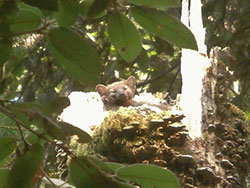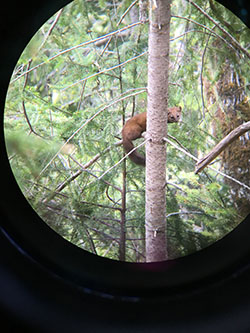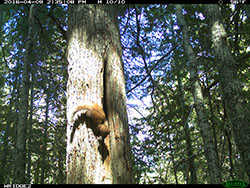
Marten resting atop a broken tree truck covered in moss and lichens. © Photo by Marx Marquez of Green Diamond, all rights reserved.

Marten in tree viewed through spotting scope. © Photo by Marx Marquez of Green Diamond, all rights reserved.

Marten climbing down tree trunk with rodent in mouth. © Photo courtesy of Green Diamond, all rights reserved.
A small population of a rare member of the weasel family has an improved chance at expanding its range, thanks to a joint effort between a forest products company and a state agency.
Green Diamond Resource Company recently signed a safe harbor agreement with the California Department of Fish and Wildlife (CDFW) to help assist in the recovery of the Humboldt marten. The agreement includes commitments by the company to create a 2,100 acre no-harvest reserve area for the marten, a 127,000 acre special management area for marten dispersal and monitoring, and dedicated funding and in-kind resources to support a possible assisted dispersal program and studies of how the martens use managed forests and adjacent public lands.
“We are looking forward to partnering with Green Diamond and exercising this relatively new safe harbor tool to facilitate and fund research and monitoring – and perhaps even help martens reconnect between the Six Rivers National Forest and the Redwood National and State parks,” explained CDFW Senior Environmental Scientist Jon Hendrix, who oversees the Timberland Conservation Program in CDFW’s northern coastal region.
Humboldt martens have been detected in the agreement’s no-harvest reserve area located on Green Diamond property and on the periphery of the company’s other lands covered by the agreement. The purpose of the agreement is to look ahead and voluntarily, proactively manage the land, in the hopes of increasing the presence of (and use by) a species that is protected by the California Endangered Species Act.
Humboldt martens were thought to be extinct in California until a small population was rediscovered in 1996 in portions of their historic range. Today, their known distribution in California is limited to areas of Humboldt, Del Norte and Siskiyou counties. In addition to the small population on Green Diamond property, Humboldt martens have also been detected on National Forest lands near tributaries of the Middle Fork of the Smith River.
In February 2016, the California Fish and Game Commission accepted a petition requesting the Humboldt marten be added to the list of threatened or endangered species under the California Endangered Species Act (CESA). CDFW has initiated a status review of the Humboldt marten which is nearing completion and presentation to the California Fish and Game Commission. During the candidacy review period, the Humboldt marten has been afforded all the legal protections provided under CESA.
In early 2016, Green Diamond applied for a California State Safe Harbor Agreement (California Fish and Game Code, sections 2089.2 – 2089.26) for Humboldt marten. The application included approximately 364,000 acres of Green Diamond’s timberlands, of which, approximately 137,000 acres fall within nine miles of the currently known Humboldt marten populations.
“Green Diamond has consistently applied a proactive view of forest stewardship and a science-based approach to managing its forests to the benefit of special status species such as northern spotted owls, salmon, steelhead and now, the Humboldt marten,” said Keith Hamm, Manager of Conservation Planning for the Green Diamond California Timberlands. “We embrace the opportunity to expand the marten population under this agreement and learn more about how marten use the company’s managed forests.”
Although incidental take of Humboldt marten is authorized in the agreement, the goal is to conserve, protect, restore and enhance the martens’ habitat. Also included are specific measures to increase Humboldt marten populations and create new habitats.
The Safe Harbor Agreement itself is good for 40 years. It is structured to provide the opportunity for neighboring landowners to enroll their lands in the agreement and contribute to efforts to recover marten populations.
To learn more, please visit CDFW’s Timberland Conservation Program webpage, www.wildlife.ca.gov/Conservation/Timber.
More information about CDFW’s Safe Harbor Agreement Program Act can be found at, www.wildlife.ca.gov/Conservation/CESA/Safe-Harbor-Agreements.
###
Top Photo: Collared marten in tree courtesy of Matt Delheimer. All other photos copyright of Green Diamond.